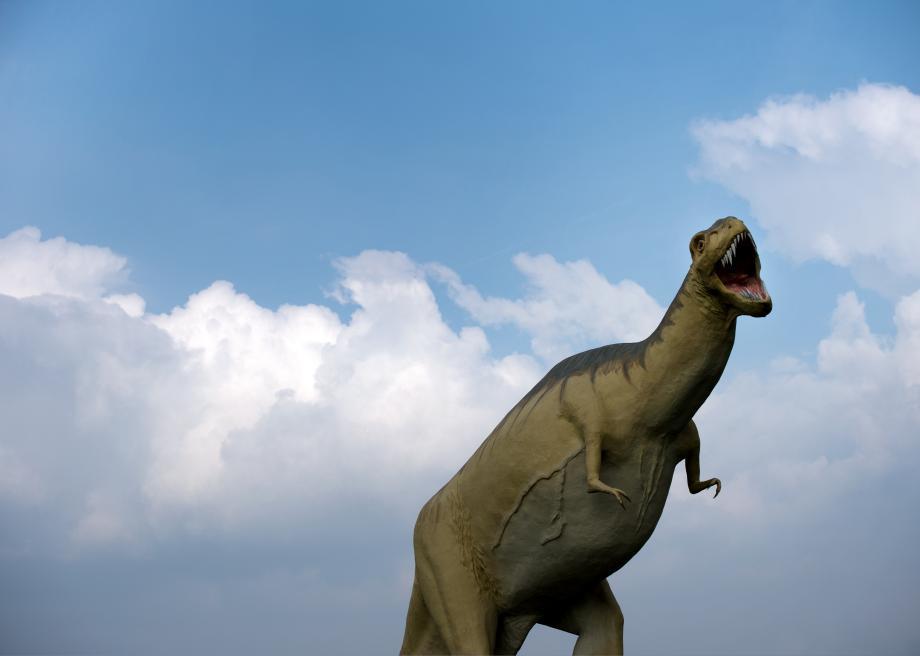Atlas Obscura on Slate is a blog about the world’s hidden wonders. Like us on Facebook, Tumblr, or follow us on Twitter.
The world’s first dinosaur park, Crystal Palace Dinosaurs in London, did not have a Tyrannosaurus rex. A glaring omission, you might think, but an understandable one: the park opened in 1854, over 50 years before the T. rex species was named.
Dinosaur parks, whether Victorian fields of stone sculptures or Jurassic Park-influenced, animatronically enhanced attractions, reflect not only the technology of their time, but the paleontological knowledge. As more fossils are discovered, and more revisions to classification and rendering made, these parks become time capsules populated by creatures that are often, in retrospect, kinda goofy looking.
In 1842, English paleontologist Richard Owen analyzed the fossils of three Mesozoic-era reptile genera—Megalosaurus, Iguanodon, and Hylaeosaurus—and found enough similarities to establish a new taxonomic group. He named this group dinosauria, from the Greek deinos (“terrible”) and sauros (“lizard”).
It was Owen who spearheaded the development of Crystal Palace Dinosaurs, a collection of life-sized models that would constitute the first publicly accessible prehistoric theme park. To realize this vision, Owen teamed up with sculptor and natural history artist Benjamin Waterhouse-Hawkins, who was fresh from overseeing London’s Great Exhibition of 1851.
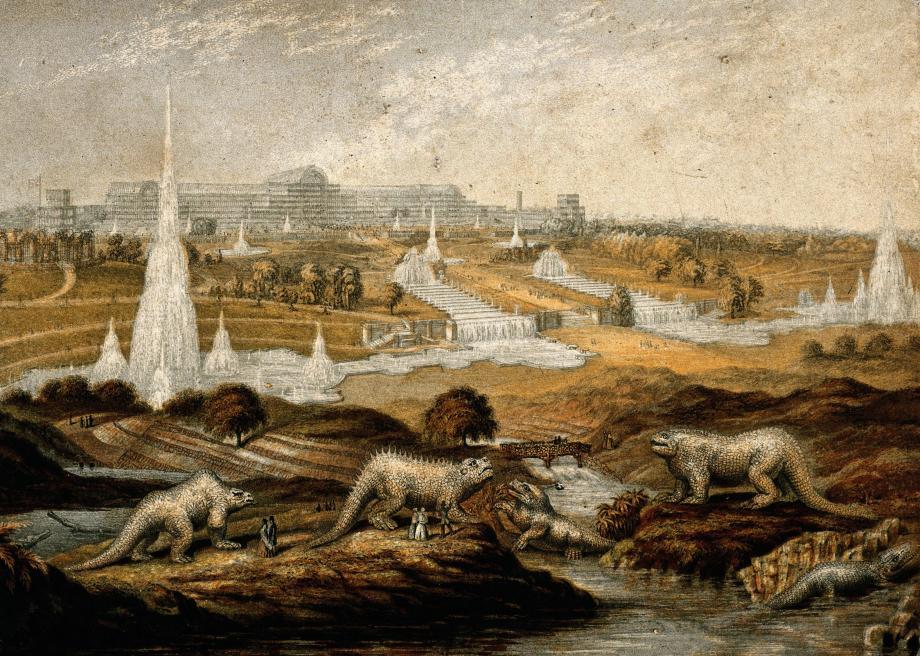
Image: Wellcome Library, London
Waterhouse-Hawkins spent three years sculpting over 30 dinosaurs and other prehistoric creatures under Owen’s guidance. After the animals were completed, Waterhouse-Hawkins celebrated with a banquet on the last day of 1853, held, in the words of Edward MacDermott’s 1854 guide to Crystal Palace, “within the carcass of one of his antediluvian monsters.” Twenty-one guests were seated to dinner inside a mold that had been used to cast one of the park’s iguanodons. (MacDermott noted that “When the more substantial viands were disposed of, Professor Owen proposed that the company should drink in silence [to] ‘The memory of Mantell, the discover of the iguanodon,’ the monster in whose bowels they had just dined.”)
Though public enthusiasm for the park was high—“terrible lizards” being an exciting and mysterious new thing for Victorians—Crystal Palace struggled financially. Sculpting each model was an expensive undertaking, and funding ran out before Waterhouse-Hawkins could create his full planned roster of stone animals. As palentological discoveries in the late 19th century caused revisions in the rendering of dinosaurs—influenced by the evolutionary theories evinced in Charles Darwin’s On the Origin of the Species, published in 1859—Crystal Palace’s creatures became less and less accurate. By the dawn of the 20th century, the park had become run-down and risible.
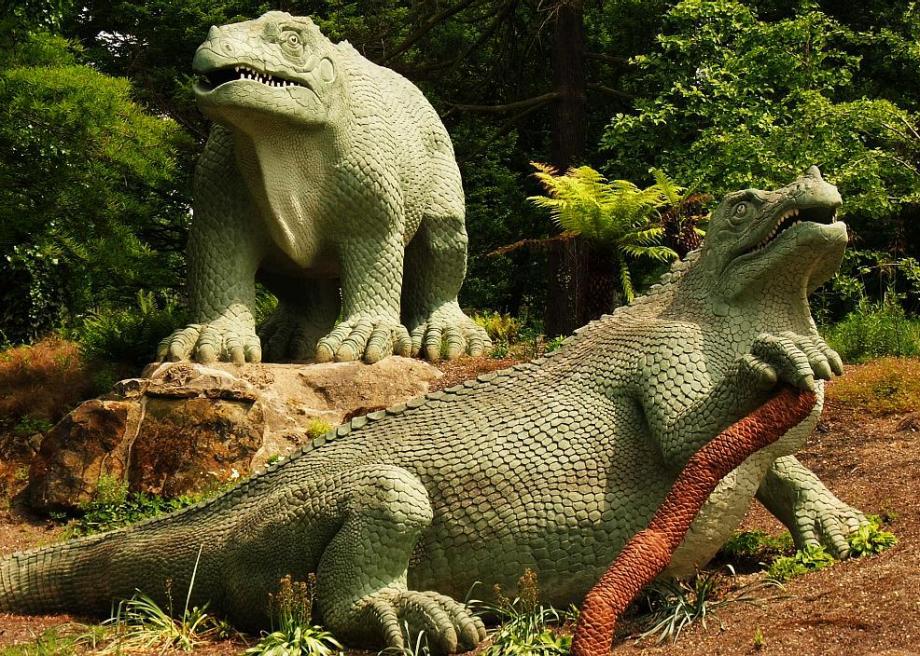
In the U.S., dinosaur parks didn’t become part of the culture until the 1930s, which saw the construction of two roadside attractions: Dinosaur Gardens in Ossineke, Michigan, and Dinosaur Park in Rapid City, South Dakota. Both are still open, and both have obsolete depictions of dinos—after visiting Dinosaur Gardens this summer, a reviewer on TripAdvisor wrote that, while there, “a five-year-old girl pointed out that the forearms of the T. rex sculpture should have just two fingers, not three.” (Technically, the T. rex is now understood to have a small vestigial metacarpal, but the kid was on the money.)
With its rounded silhouette and dopey smile, the T. rex at Rapid City is a Barney-caliber dinosaur, or perhaps even sub-Barney—it doesn’t have teeth:

Photo: Carol M. Highsmith’s America, Library of Congress, Prints and Photographs Division
Compare that goofy supposed carnivore with a T. rex built for the 1964 World’s Fair:
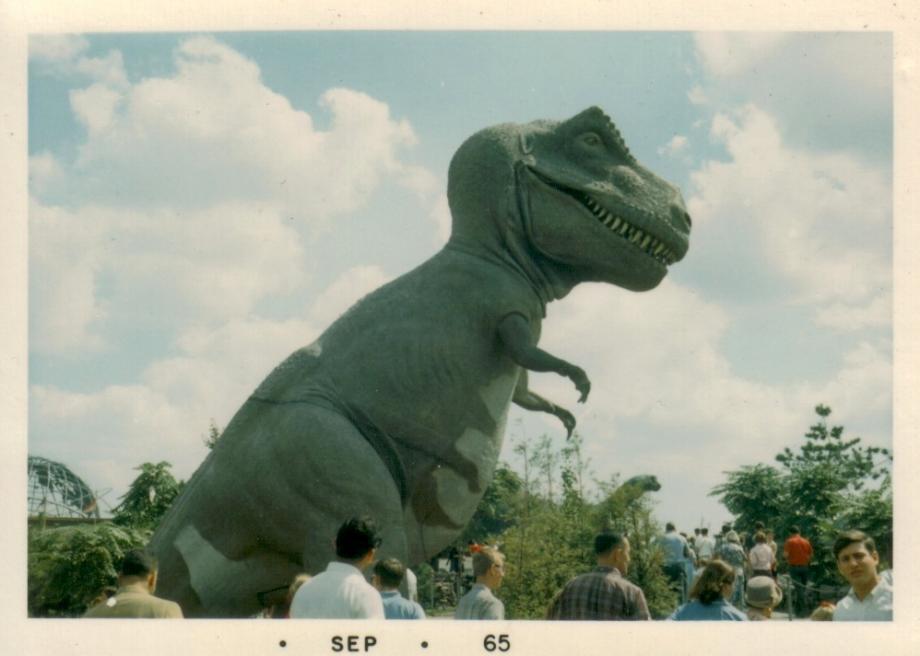
and a version created for JuraPark, a Polish dinosaur park that opened in 2004:
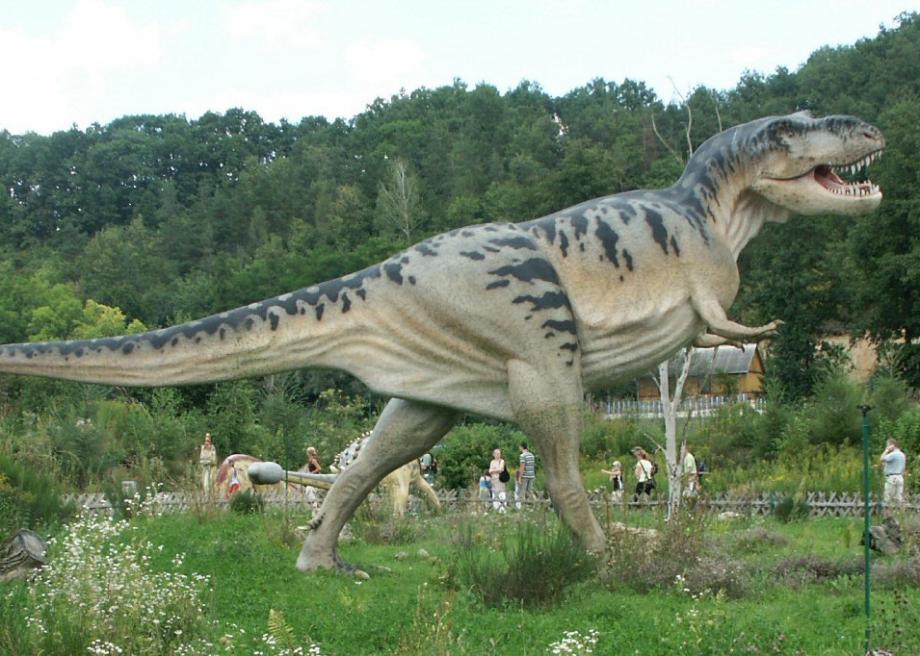
During the 1960s, with the Flintstones as a pop-cultural backdrop, further fossil discoveries and analysis caused a significant shift in paleontology—a “dinosaur renaissance,” as paleontologist Robert T. Bakker called it in a 1975 article for Scientific American. In the article, Bakker presented evidence for a reframing of dinosaurs from “symbols of obsolescence and hulking inefficiency” to more sophisticated, complex animals with a still-living descendent: birds.
This revolutionary info-dump shifted scientific and public perception of dinosaurs. No longer were they terrible lizards, but more mammalian and easier to anthropomorphize. Pop-culturally, dinos were increasingly depicted as cuddly, friendly, and emotional, as anyone who went to Pizza Hut in the early ‘90s and received a Land Before Time hand puppet can attest. Then there was Jurassic Park—not so cuddly and friendly, but certainly anthropomorphized, as in the case of the doorknob-turning, villainous velociraptors.

With the influence of Jurassic Park and the development of animatronics, dinosaur parks have shifted from being collections of statues to high-tech, interactive, often frightening experiences. At Field Station: Dinosaurs in Seacaucus, New Jersey, Australian-accented guides lead school children through themed, technology-enhanced activities designed to educate them on paleontology—and scare the crap out of them.
Miles Portek worked as a Field Station dinosaur handler this year, operating a 15-foot, 90-pound T. rex puppet equipped with a microphone to amplify his roars and a camera for monitoring the reactions of the kids. It’s a role he relishes: “My expressions will be the same as the T. rex,” he says. “All the noises that the T. rex makes, I make myself. I’m roaring, I’m purring, it’s basically a life’s dream come true, to realistically be a dinosaur terrorizing children.”
Here’s what that looks like:
While many of the old dino parks have shuttered, and some have been repurposed—such as the Cabazon dinosaurs in California, popularized by Pee-Wee Herman and now housing a Creationist museum in the belly of the Apatosaurus—new dinosaur parks continue to open around the world. Giant, animatronic animals, however, don’t come cheap, and a few of the flashy new parks strugge to recoup costs.
One of the more ostentatious examples in recent years is Palmersaurus, a dinosaur park that opened on Australia’s Sunshine Coast in December 2013. The park is named after its creator, Clive Palmer, an egomaniacal billionaire and politician who describes himself as a “National Living Treasure” in his Twitter bio and has plans to build a full-sized replica of the Titanic. Palmersaurus, billed as “the world’s largest dinosaur park,” consists of 160 robotic dinos that roar at the push of a button. The only problem is that no-one’s coming to see them.
The dinosaurs are located at Coolum Resort, a once ritzy, now neglected vacation spot whose golf course was used for PGA tournaments until the arrival of Palmersaurus caused the PGA to withdraw from the location. Palmersaurus’ mascot, a 33-foot-tall, roaring T. rex nicknamed Jeff, was installed right next to the green, in a move widely considered tacky and embarrassing. Bewildered former Sunshine Coast councillor Russell Green told Australia’s ABC News “It’s almost turning into a scene out of Happy Gilmore where you putt down the fairway, you bounce the ball off T. rex’s left leg and get it into the 18th hole—it’s quite bizarre.”
By contrast, streams of visitors still stroll among the restored prehistoric sculptures at Crystal Palace. Though they may not strictly resemble the dinosaurs that roamed the earth during the Mesozoic Era, they serve as enduring reminders of our paleontological progress.

